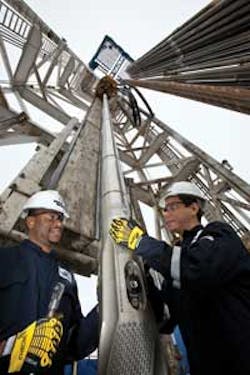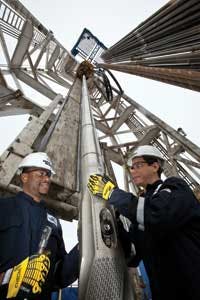P.2 ~ Service providers advance MWD/LWD technologies-full
View Article as Single page
Enteq Upstream
The value of real-time LWD/MWD measurements to improve drilling efficiency while providing critical reservoir information such as the locations of so-called "sweet spots" has begun to influence traditional wireline users to switch when it makes economic sense. The growing popularity of the technology has instrument providers developing tool systems for sale or lease. This has opened up markets once considered the exclusive territory of the large, integrated service companies.
Now, service providers who previously lacked the R&D budgets to develop their own LWD/MWD capabilities can offer competitive services using tool systems developed by companies such as Enteq Upstream Plc. Previously focused on MWD with its Enteq-XXT technology platform, the company has recently negotiated a memorandum of understanding with Target Well Controls of Aberdeen, Scotland. The objective is to integrate the latter's Target Propagation Wave Resistivity (PWR) technology with Enteq's to offer a more comprehensive LWD/MWD capability. Compatibility with Geolink systems is an added bonus. PWR is a fully tested LWD technology, and has been field-proven over the past decade. Tool systems have been developed for all current collar sizes (4.75-in., 6.75-in., 7.75-in., and 8.25-in.) plus a unique slim hole 3.50-in. diameter system for the Russian market. According to the company, the addition of the PWR to the Enteq-XXT MWD product line will greatly advance the capabilities of users making them more competitive in global markets.
The PWR system offers single frequency (1 MHz) borehole compensated propagation wave resistivity that operates in any drilling fluid. Like other propagation systems the tool measures both amplitude and phase shift. It is battery-powered and stores recorded measurements in 2 MB of selectable rate, non-volatile memory. Measurement updates are telemetered to surface by mud pulse or electromagnetic transmission every 60 sec on average. All sizes are rated to 20,000 psi and 300°F (150°C). An optional mud pressure while drilling sensor is available.
The tool's depth of investigation varies with formation resistivity and measurement type. Phase resistivity can see as deep as 69.3-in. and amplitude resistivity can see to 133.4-in. in a 20 ohm formation. In a 20 ohm formation, vertical resolution varies from 7.5 ft (Phase) to 15.7 ft (Amplitude).
APS Technology
APS Technology's Wave Propagation Resistivity Sub (WPR) is a spatially compensated, 400 kHz/2 MHz tool designed for wireline-equivalent LWD services in all mud types. Applications include geosteering, correlation, pore pressure trend analysis, casing point selection, wireline replacement, logging while tripping, and logging with and without the flow switch enabled (for air- and foam-drilled wells). WPR is available in 3.5-in., 3.75-in., 4.75-in., 6.75-in., and 8.0-in. sizes. APS offers a subwall-integrated pressure-while-drilling option for 4.75-in., 6.75-in. and 8.0-in. WPR.
The company offers a full suite of MWD services that can be run singly or in combination with the WPR service. These include a SureDrill drilling optimization service that combines real-time surface and downhole measurements with drillstring modeling. Experience has been excellent with increased penetration rates and extended bit life. Early warning of drilling dysfunctions is included to minimize unplanned trips. The company's SureShot MWD offers directional and inclination measurements along with gamma ray and mud pulse telemetry, as well as a software extension vibration memory module (VMM) that can analyze bit bounce, whirl, and stick-slip vibration. A drilling dynamics module (DDM) measures weight-on-bit, torque-on-bit and bending-on-bit along with temperature and internal and external mud pressure.
Weatherford
Weatherford continues to push the envelope in deep, hot wells with a record-setting performance at 28,500 psi for a Quad-Combo combination tool string (resistivity, density, neutron, and sonic) in the deepwater Gulf of Mexico. Since 2000, the company has focused on developing tools capable of withstanding hostile bottomhole environments. The company's Revolution Rotary Steerable System has been a leader in HP/HT applications. Unlike wireline systems that are only exposed to harsh bottomhole conditions for a short period, LWD/MWD tools must be able to survive and function for many days in extreme environments.
The company has announced advances in pulse detection that extend the distance over which steering commands can reliably be sent and received downhole, as well as real-time log data telemetered to surface. The drilling fluid and cuttings entrained in it can impede the ability to detect and decode the signals. Considerable engineering work has been invested in pulse-detection circuitry in conjunction with the company's hostile environment efforts extending its overall deep hole capabilities.
Baker Hughes
The FASTrak LWD service enables operators to make an unlimited number of formation pressure measurements and up to 16 single-phase formation fluid samples on a single trip. The tool can also make real-time insitu measurements of reservoir fluid properties before committing a sample chamber.
Recently offshore Vietnam, the service was run in an S-profile deviated well. Typically, a drill pipe-conveyed wireline tester would have been run, but there was added risk of a stuck tool and extended rig time would have been required. By running the test tool as part of the LWD string, all measurements could be taken contemporaneously with drilling operations. Baker Hughes was challenged to establish accurate individual pressure gradients over a succession of thin beds of variable fluid mobility and different fluid compositions. A high level of filtrate invasion was predicted, so clean-up time could have been problematic.
On a single descent into the well, 60 pressure tests were acquired, an industry record for competing technologies in the marketplace. Based on real-time in situ fluid analysis that identified highly-prospective beds, six oil samples were attempted and successfully acquired. The tool features SmartPad technology that senses whether the packer element has the potential to lose seal. If so, pad pressure is automatically increased to maintain seal integrity.
According to the company, $2.2 million in rig-time and equipment savings accrued to the customer.

